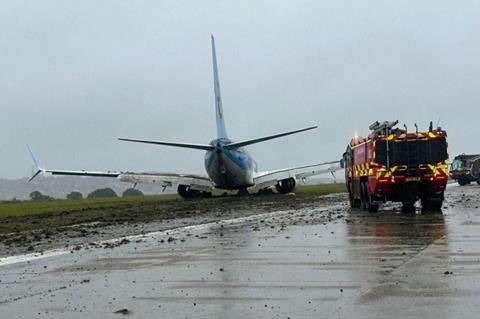Pilots of a Boeing 737-800 involved in a landing excursion in wet conditions at Leeds-Bradford could have kept the jet on the runway, investigators believe, but might have been influenced by unexpected juddering from a nose-wheel bearing failure.
The TUI Airways aircraft had been arriving from Corfu, in stormy weather, on 20 October last year.
Its crew conducted an ILS approach to runway 14, selecting maximum autobrake, after confirming crosswinds from the left were within limits.
Using right rudder to de-crab, the captain landed the jet in the touchdown zone, with autobrake and reverse-thrust activating normally.
As the captain reduced right-rudder input the aircraft began to yaw left, and right rudder was re-applied.
But the full range of rudder was “not used to correct the drift”, says the UK Air Accidents Investigation Branch, because the crew felt a “significant judder” when right-rudder was applied.
Autobrake was disconnected at 107kt – eliminating wheel braking for about 8s – and the reverse-thrust was disengaged at 86kt.

Although there was an increase in right-rudder input, this was “periodically reduced” to zero, says the inquiry, and the jet continued to yaw left.
The crew attempted to use asymmetric braking and the steering tiller to regain control as the 737 neared the left edge of the runway, but the jet veered off at 55kt groundspeed. It came to rest in mud about 6s later.
None of the 195 passengers or six crew members was injured, and the aircraft (G-TAWD) sustained only minor damage, mainly to its tyres.
Boeing simulation and analysis of the landing found that the aircraft’s braking had not been friction-limited, despite the wet runway surface, and that the 737 probably achieved the equivalent of dry braking action.
The airframer also concluded that, under the conditions of the landing, about 2-3° of right-rudder input, increasing to 4°, would have kept the aircraft on the runway centreline.
This simulated rudder input, the inquiry points out, involved a continuous pedal application – rather than the periodic inputs of the crew, during which the rudder returned to neutral.
“Recorded data shows there was a significant amount of right-rudder input available to the pilot which was not used,” says the inquiry.
“The simulation calculated by the manufacturer suggests that the available rudder would have been sufficient to correct the deviation and prevent the runway excursion without cancelling the autobrake and cancelling reverse-thrust.”
But the inquiry acknowledges that the captain might have experienced a “startle reflex” from the unexpected juddering, which investigators attribute to the failure of a nose-wheel bearing during the landing roll.
“This would explain an interruption of the task of increasing the rudder input to prevent the deviation from the centreline,” it says.
But it adds that the deviation occurred 18s before the 737 came to a stop, and that – while surprise might have been a factor – the reasons why the captain did not attempt to apply more right-rudder input, in spite of the juddering, are “not clear”.





























